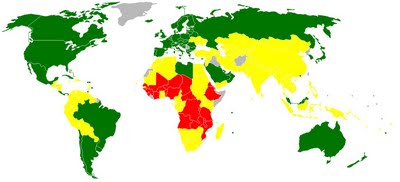2007 UN Human Development Index: Africa Remains The Forgotten Continent; Climate Change Now Clearly Visible Worldwide

The 2007 UN Human Development Index has been released today. You can read a summary and download it here.
The Human Development Index calculates algorithms that factor-in life expectancy, literacy rate, school enrolment percentage, and GDP. The results classify nations as developed (green in the Wikipedia map above), developing (yellow), or underdeveloped (red), and also provide a simple scale measuring overall quality of life.
News reports today focus on the index itself, which is the ranking of nations. Iceland has taken the top sport for the first time since the report was created by economists in 1990. But the full 300-page report spends a great deal more time talking about climate change, as it is the biggest risk facing underdeveloped nations. Looking at the index, it is clear that the nations of the northern hemisphere consume far more resources than the nations in the south (Brazil, Australia, and New Zealand being major exceptions). And since most of the world's countries are north of Equator, let's try to be fair and say that the south begins around 10 degrees north latitude (so anything south of Nicaragua / southern India / Philippines is "south").
This report ties that division to the issue of climate change, which will drastically affect more people in the south than in the north. Not that the north will be unaffected, of course. But the entire sub-Saharan region, Bangladesh and Sri Lanka, plus parts of southeast Asia and Micronesia / Oceania are at grave risk due to shortages in fresh water and a rise in ocean levels.
So the warning bells continue to sound for our planet.